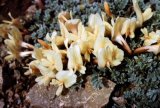ORNAMENTAL PLANTS OF HORTICULTURE VALUE
Selection of perennials
Astragalus L.
Milk Vetch |
Fabaceae (Leguminosae) |
About 2000 species on every continent except Australia,
mainly in the temperate regions of the Northern Hemisphere;
in the FSU flora - about 850 species, mainly in Central Asia
and the Caucasus. Among them are annual, biennial and perennial
herbs, subshrubs and shrubs. There are many cushion and
mat-forming plants (A. chionanthus M. Pop., A.
stipitatus Benth. ex Bunge). Some plants are tall
(A. sieversianus Pall. is 150 cm high) and very attractive
when flowering or fruiting. Most species are mountain xerophytes
and can grow only on dry, well drained, gravelly soil why they so
rarely appear in cultivation. Several species can be recommended
for regions with warm and dry climates (zones 6, 7). Still other
species are cold-resistant and can be comfortably grown in zones
4, 5. A brief list of investigated species follows and includes
their Latin names, plant height during flowering (in cm), flower
color and month of flowering in nature. Cold-resistant plants are
marked by CR. Low-growing plants grow well in rock gardens,
tall-growing species can be used in flower beds. All species are
unknown in cultivation except A. onobrychis.
A. aksuensis Bunge - 50-90, yellow, July. CR.
New.
A. alopecias Pall. - 50-90, yellow, May. CR.
New.
A. brachypus Schrenk. - 60-90, purple, May.
CR. New.
A. brachytropis (Steven) C. A. Mey - 15-30,
violet, June. New.
A. brevifolius Ledeb. 3-6, yellow, June.
New.
A. cancellatus Bunge - 25-40, violet , May.
New.
A. caraganae Fisch. et C. A. Mey. - 15-45,
yellow, May. New.
A. ciceroides Sosn. - 25-60, yellow, June.
New.
A. cornutus Pall. - 30-50, red-violet, June.
CR. New.
A. dilutus Bunge - matformig, purple, June.
CR. New.
A. dolichophyllus Pall. - 5-15, yellow, May.
New.
A. finitimus Bunge - 20-40, yellow, May.
New.
A. glycyphyllos L. - 45-90, yellow, May. CR.
New.
A. lunatus Pall. - purple, April. New.
A. maximus Willd. - 60-100, yellow, May.
New.
A. mesites Boiss. et Buhse - 25-35, purple,
June. New.
A. mongholicus Bunge - 25-40, yellow, July.
CR. New.
A. onobrychis L. - 35-60, blue, April.
A. perrarus Boriss. - 25-40, violet, May.
New.
A. polygala Pall. - 2-5, blue, April. New.
A. regelii Trautv. - 6-20, yellow, June. New.
A. rubtzovii Boriss. - 12-15, yellow, May. CR.
New.
A. sieversianus Pall. - 60-150, yellow, May.
CR. New.
A. sphaerocephalus Steven et C.A Mey.- 14-30,
purple, May. CR. New.
A. suffruticosus DC. - 20-60, red-lilac, June.
CR. New.
A. vulpinus Willd. - 25-50, yellow, May. CR.
New.
|

